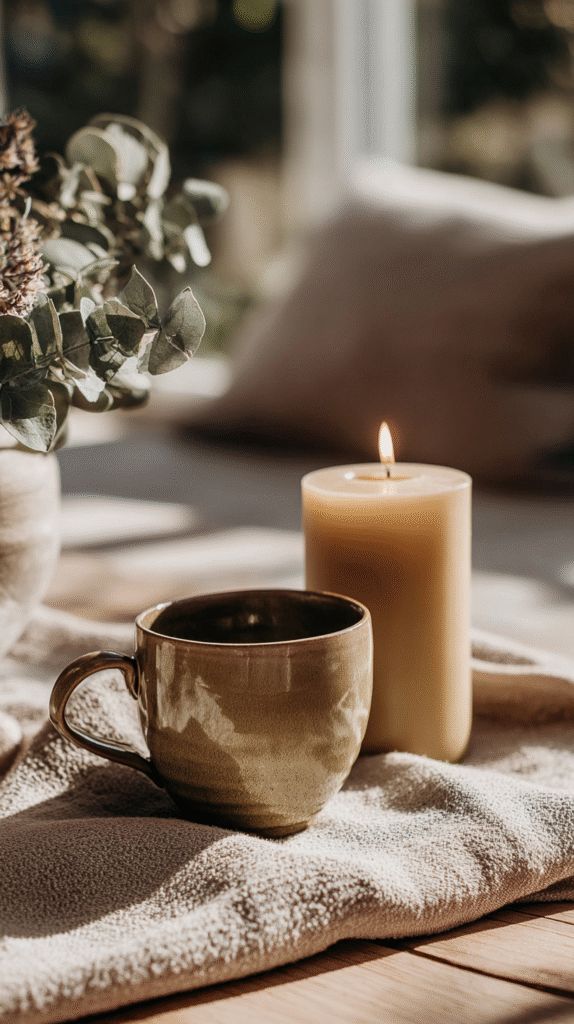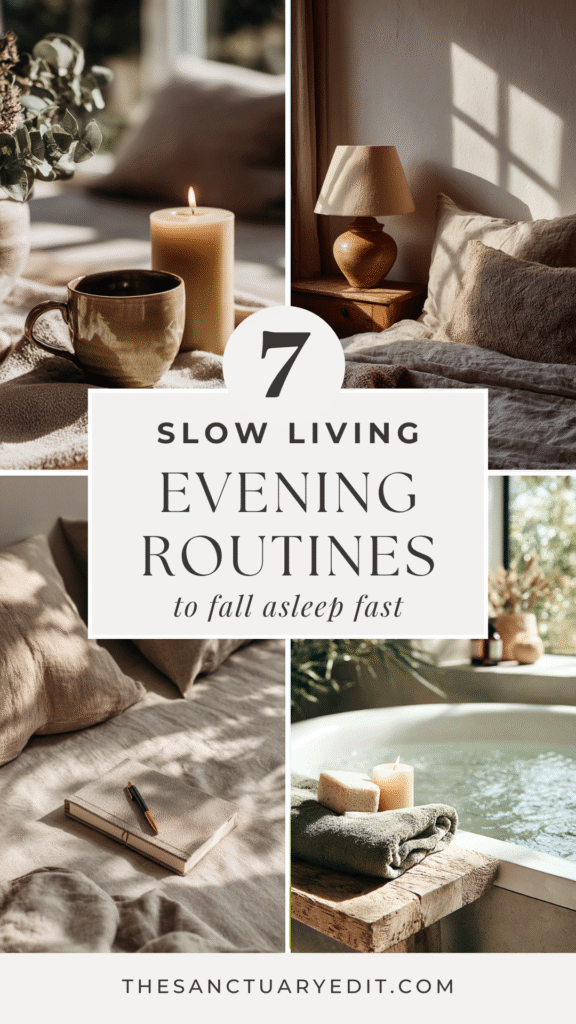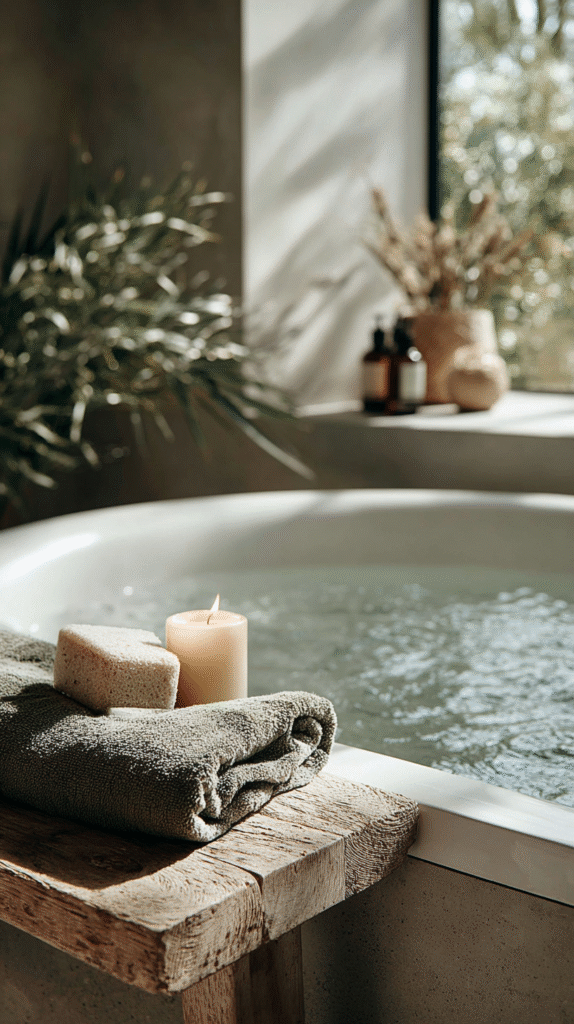This post may contain affiliate links, including those from Amazon Associates. If you make a purchase through these links, I may earn a commission at no additional cost to you. Learn more about our affiliate policy.
Evenings can feel like the busiest part of the day can’t they?
The house is full of noise, undone tasks weigh on your mind, and your body holds the leftover energy of the day.
By the time you slip into bed, sleep feels far away.
What if instead of collapsing into the night, you guided yourself gently toward rest?
Slow living evening routines are about creating a series of cues, small rituals that invite your body and mind to soften.
When practiced with intention, they become signals that say: it’s safe to let go now.
Here are seven simple routines to help you fall asleep more quickly and wake with more ease.
Dim the Lights and Begin a Ritual

Light shapes how your nervous system responds to the evening. Bright overhead bulbs tell your body it is still daytime, while softer, warmer light encourages the natural release of melatonin.
Begin your evening by dimming lamps, lighting a candle, or switching to amber bulbs.
This small shift changes the atmosphere instantly.
The room feels calmer. The edges of the day soften. If you have a favorite candle, lighting it at the same time each night creates a signal of transition.
Over time, your body will recognize this cue as the start of your wind-down ritual.
Power Down Screens and Notifications
Phones and laptops pull your mind outward into news, social feeds, and unfinished tasks.
The blue light disrupts melatonin, and the constant stimulation keeps the nervous system alert long past bedtime.
Try setting a screen-off time, even if it’s just thirty minutes before bed.
Place your phone in another room or switch it to “Do Not Disturb.”
Choose one quiet alternative like reading, listening to soft music, or simply sitting with tea.
The absence of screens creates a pocket of mental quiet. Your mind begins to drift inward instead of scanning outward.

Gentle Movement or Yoga
Evenings can hold the day’s tension, shoulders tight from work, legs restless from sitting, jaw clenched from stress.
Slow movement helps release this stored energy so your body can rest.
You don’t need a long practice. A few minutes of stretching, child’s pose, or lying twists can shift you into the parasympathetic state where rest becomes possible.
Move with intention, noticing how each muscle softens. If you prefer, a slow walk outside or barefoot stretches by the window can offer the same release.
What matters is giving your body a way to exhale before you lie down.
A Soothing Bath or Mindful Skincare

Water has a way of cleansing more than the skin, it signals closure, a boundary between the demands of the day and the rest to come.
A warm bath with dim light and quiet can lower cortisol and prepare the body for deeper sleep.
If a bath isn’t possible, a simple mindful skincare routine can serve the same purpose.
Instead of rushing through your evening cleanse like it’s another task to check off your list, slow down.
Notice the scent of your cleanser, the feel of water on your skin, the comfort of applying moisturizer slowly.
This ritual doesn’t need to be elaborate. It is the intention, choosing to care for yourself with gentleness, that brings the shift.
Journaling or Body-Scan Meditation
Racing thoughts are one of the biggest barriers to falling asleep. The mind replays conversations, lists tasks, or runs through future worries. Creating space to release those thoughts can help the mind settle.
Journaling is one way to do this. Write down what’s on your mind, even if it’s only a few lines.
Capture one intention for tomorrow or one thing you are grateful for tonight. If journaling doesn’t feel appealing, try a body-scan meditation.
Lie in bed, close your eyes, and move your attention slowly from head to toe, noticing where tension lingers. With each breath, soften that area a little more.
These practices remind your mind and body that there is nothing left to hold onto.
Bedtime Consistency
Your body thrives on rhythm. Going to bed and waking at similar times helps regulate your circadian rhythm and makes it easier to fall asleep. Experts often suggest being in bed about nine hours before your intended wake-up time.
This allows enough room for natural sleep onset and the cycles your body needs.
Creating consistency doesn’t have to mean rigidity. You don’t need to be exact to the minute.
Think of it as choosing a window that works for your life. Over time, this steady rhythm will teach your body when to release and when to rise, making sleep come more easily.
Optimize Your Environment for Calm

Finally, consider the space you are sleeping in. Your bedroom should be the calmest environment in your home. Cool air, soft darkness, and quiet surroundings all signal safety to the nervous system.
Try blackout curtains, a sleep mask, or a small fan for gentle white noise.
Choose bedding that feels natural and breathable like cotton, linen, or organic fibers that soothe your skin. Keep surfaces clear so your eyes rest on calm instead of clutter.
Even the smallest details like an open window, a spritz of lavender on your pillow, or a soft throw can help your body recognize this space as a sanctuary for sleep.
Weaving These Routines Together
You don’t need to do all seven every evening. Start with one or two that feel easiest to layer into your life.
Maybe you begin by dimming lights and switching off screens earlier. Or you find comfort in a short body scan before bed. What matters is creating a rhythm that feels grounding, not pressured.
These rituals are not about creating a perfect routine. They are about giving yourself permission to land softly at the end of the day. Over time, these practices become natural, and sleep follows with more ease.
Closing Encouragement
Falling asleep quickly begins long before your head touches the pillow. It starts with how you guide yourself through the evening. By creating simple, sensory rituals like dimming the lights, stretching your body, caring for your skin, releasing thoughts, you tell your nervous system that it is safe to rest.
Choose one ritual tonight. Let it be your quiet cue. Tomorrow, notice how it feels to wake with more calm. Then, little by little, layer in others until your evenings become a gentle pathway to rest.
Your nights don’t need to be rushed or restless. They can be soft, spacious, and steady. And from that place of calm, sleep will come more easily.


